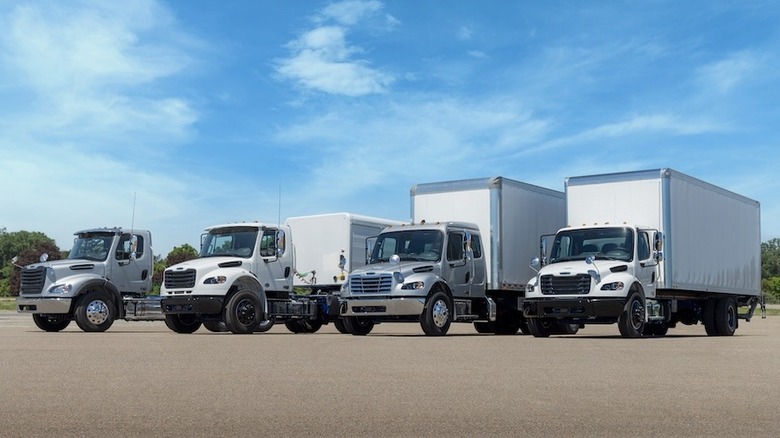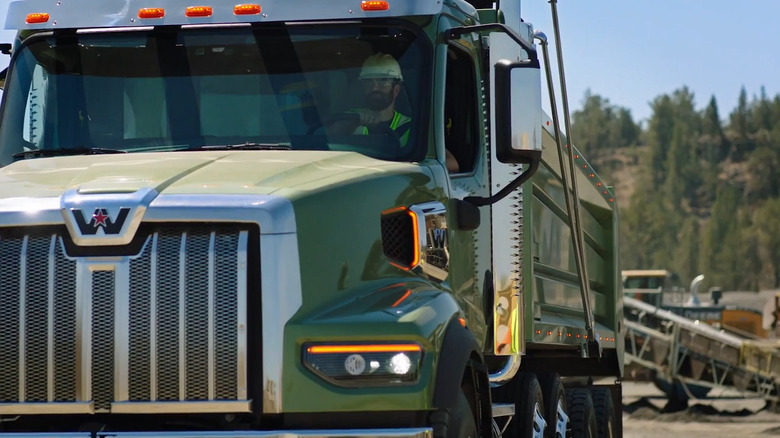Which Semi Trucks Use Cummins Engines?
If you ever get on a highway, chances are strong that you're going to be passing a significant number of semi-trucks while on the road. These large cabs designed for hauling the heaviest payloads you can imagine flood America's asphalt every single day, carrying who knows what to who knows where. When it comes to how these trucks actually operate, we often give less thought to what could actually be powering such a behemoth. Well, that semi-truck engine is most likely powered by diesel fuel and produced by one of two companies: Detroit Diesel or Cummins.
Cummins has one of the widest reaches you can imagine when it comes to powering America's most popular semi-trucks. The company has simply built a reputation as the place to go for engines of large vehicles like RVs, buses, and semi-trucks. Cummins goes back over 100 years, and its focus has barely wavered in all that time. Currently, six of the biggest semi-truck brands in the country utilize Cummins diesel engines including Freightliner, International, Kenworth, Peterbilt, Volvo, and Western Star. Let's take a closer look at each.
Freightliner semi-trucks
When it comes to the United States, there is no bigger commercial truck manufacturer than Freightliner. Its lineup of various sizes is the best-selling brand in the game, making up about 40% of the market share in the country. When something is that popular, it becomes kind of a badge of honor to have your engine power it. Well, that's exactly the case with Cummins, which provides engine options up and down the Freightliner fleet.
Most notably, there's the company's signature heavy duty semi-truck, the Freightliner Cascadia, which was first introduced for the 2008 model year. You actually have two Cummins engine options available for this particular model, the X12 and X15. These are both diesel engines that you are going to see come up time and time again on this list, powering different semi-trucks. While one might expect these to be V8 engines because of the size of the trucks, they're actually inline-six engines (though Cummins does make V8 engines). The 11.4L X12 can have an output up to 500 hp and 1,700 lb-ft of torque, while the larger 14.9L X15 can reach a whopping 675 hp and 2,050 lb-ft of torque.
On a slightly smaller model like the Freightliner 114SD Plus, the X12 is available and not the X15. However, here you may also utilize the Cummins L9 engine, an 8.9L straight-six engine mainly made for buses, if the law where you're driving permits it.
International semi-trucks
Another major player in the semi truck business is International. This is a company that has its roots stretch all the way back to the 1830s with farming equipment to now being a massive provider of some terrific semi trucks. Unlike the previously mentioned Freightliner, International does not just produce trucks, buses, and other forms of transportation. The company also makes its own engines and utilizes them across the company's fleet. In fact, many different truck families from the company only have an International engine as an option for those trucks. However, that is not true across the entire company, as Cummins does get to make an impact on some of International's heavy duty semi trucks.
Most notably, there is the International LT series. This is a line that features five different cab size options, depending on what kind of payload you will be hauling, and although the 12.64L International S13 engine will be what comes standard for these semi trucks, the Cummins X15 is also available. If pure performance is what you are looking for, then Cummins is the way to go here, as its maximum output outdoes the International engine by 50 hp and 200 lb-ft of torque.
The X15 is also an option for the company's HX series, which are the semi trucks more for construction sites than long-distance hauling. Like the LT series, the International S13 comes standard, but while the torque improvement remains consistent with that series using the X15, the horsepower increase is even larger, increasing the maximum output by 30 to 90 hp, depending on the model. There's little reason not to choose the Cummins engines here.
Kenworth semi trucks
At one point, Kenworth semi trucks utilized engines made by Cummins all across its arsenal of heavy duty semi trucks. Models like the W990 and the T680 gave you the ability to have one of those X-series diesel engines that Freightliner and International trucks have been enjoying. However, that does not seem to be the case anymore. There are some medium duty trucks where the smaller Cummins engines are available, but the big semi trucks we are talking about right now seem to have completely embraced engines made by Paccar. This makes sense, as Kenworth is one of Paccar's subsidiaries, and it would want to utilize its own engines, like the Paccar MX-13 that comes standard with the current W990 semi.
However, there is one exception to this, and that is the Kenworth T880. This is the one semi truck available from the company that still has the Cummins X15 as an option, and the company does not make it easy to even tell you that it is in fact an option. If you were to get a T880 standard issue, which is a semi designed more for construction equipment hauling, it would come with a 12.9L Paccar MX-13 engine, giving you a totally acceptable 510 hp and 1,850 lb-ft of torque maximum output. On the optional list of engines that you can get instead, it mentions a couple other Paccar options and the X15. Notably, it does not say the name Cummins anywhere, almost to make you think that Paccar makes that engine. It doesn't. That is the Cummins X15 you would be getting.
Peterbilt semi trucks
Kenworth is not the only subsidiary of Paccar out on the market. Another company under that umbrella is Peterbilt. You might think that because Kenworth has restricted its usage of the Cummins diesel engines so severely that the same would be true for its sister company. For whatever reason, that is not the case. Cummins engines are very much available for Peterbilt semi trucks, just as with companies like Freightliner or International. Whether Paccar decides to limit this in the future as it did with Kenworth remains to be seen.
Of course, the Cummins engine does not come standard on the three major semi truck models from Peterbilt: the 579, 589, and 567. This is where they do share similarities with the Kenworth trucks, as the Paccar MX-13 is the base-level engine you will be getting, and the company offers several other Paccar engines as alternatives as well. For all three of these trucks, you are able to equip it with the old reliable Cummins X15 to get you a maximum output of 605 hp and 2,050 lb-ft of torque. Those numbers are far above what the Paccar MX-13 can provide, and the alternative Paccar engines do not even reach what the MX-13 is capable of generating.
These trucks also give you other Cummins engine options as well, though they drift away from diesel fuel. Instead, they offer a couple of engines powered by natural gas instead, like the Cummins ISX12N and L9N engines. This excludes the 589, which only has the X15 as an option.
Volvo semi trucks
At one point, Volvo was widely using Cummins X-series engines across the company's VNL and VNX line of semi trucks. A total of eight different models gave you the chance to have one of these engines underneath the hood. Unfortunately, that is no longer the case. Even more than Paccar, Volvo has dug in and decided that only its own engines will be the ones powering the semi trucks it manufactures. Most notably, the Volvo D11 and D13 engines are used, and depending on which model you are getting, either one could be the standard issue engine. You cannot even have the X12 or X15 as an option on these trucks anymore.
However, there is one way that Cummins still makes an impact on Volvo's lineup of powertrains for its semis, and that is with natural gas. A lot of people are rightfully dubious about utilizing natural gas. This is due in large part to the harmful environmental effects of fracking, particularly earthquakes, which is how natural gas is mined. In terms of actual engine operation, it does make it run.
While Volvo has been testing natural gas engines developed through a joint venture with Westport called Cespira, those aren't widely available yet. In the meantime, Volvo offers the natural gas-powered Cummins ISX12N to those who want it. This engine is nowhere near as powerful as the heavy-duty Cummins diesel engines mentioned thus far. It has a maximum output of 400 hp and 1,450 lb-ft of torque. If you are steadfast in your desire to use a natural gas engine, Volvo gives you this option.
Western Star semi trucks
Last but not least, we reach the final company on our list: Western Star. This is a truck manufacturer that used to have a lot more model options in its fleet than it does now, as it currently just produces three different models. Just a few years ago, the amount of trucks that Western Star made that had the option of a Cummins engine for it outnumbered the amount of vehicles it makes now in totality. Despite the slimming down of the line, that has not caused the company to eliminate Cummins engines from its options on two of its three models. Both trucks give you two Cummins options to choose from, but they are not the same two engines for both models.
First, you have the Western Star 49X. This is a vocational semi truck that gives you the option of either the Cummins X12 or X15 under the hood. Western Star doesn't make its own engines, so the other options come from Detroit Diesel. In the case of the smaller 47X truck, the X12 is still an option, but alongside that, you have the smaller L9 option as well.
Neither one features a natural gas option. For some reason, the highway semi truck that the company makes, the 57X, does not have the X15 as an option, relying solely on a trio of different Detroit Diesel engines to choose from. It perfectly works for semi trucks of a similar size for other companies, and Western Star already uses it. It would make sense to have it as an option. Alas, Cummins will have to be happy with two models using its engines.






